International Demonstration Teaching Team
for the Course of Electronics and Measurements
一、团队成员
Team Members
Damian Grzechca,博士,《电子和测量》课程外方负责教师。西里西亚技术大学自动控制、电子和计算机科学学院,电子、电气工程和微电子系教授。自动化、电子与电气工程及空间技术学科委员会委员。专注于信号处理、电子通信工程和人工智能等领域的研究。
Dr. Damian Grzechca, foreign teacher for Electronics and Measurements, Professor of the Department of Electronics, Electrical Engineering and Microelectronics at the Faculty of Automatic Control, Electronics and Computer Science, Silesian University of Technology. Member of the Committee on Automation, Electronics and Electrical Engineering and Space Technology at Silesian University of Technology. Dr. Grzechca specializes in the research of signal processing, electronic communication engineering and artificial intelligence.
Lukasz Chruszczyk,博士,《电子和测量》课程外方实验教师。西里西亚技术大学自动控制、电子和计算机科学学院,电子、电气工程和微电子系助理教授,IEEE会员。专注于模拟和混合信号电路测试、故障诊断、信号处理、数据优化以及人工智能领域。
Dr. Lukasz Chruszczyk foreign laboratory instructor for Electronics and Measurements, Assistant Professor of the Department of Electronics, Electrical Engineering and Microelectronics at the Faculty of Automatic Control, Electronics and Computer Science, Silesian University of Technology, and member of IEEE. Dr. Chruszczyk specializes in the areas of analog and mixed-signal circuit testing, fault diagnosis, signal processing, data optimization and artificial intelligence.
边飞,博士,《电子和测量》课程中方助课教师。燕山大学信息科学与工程学院光电子工程系副教授。主要从事光电信息功能材料、微结构光电材料设计等方面的研究。在教学方面,主要承担模拟电子技术、光谱学原理、激光技术等课程的教学工作。
Dr. Fei Bian, Chinese teacher for Electronics and Measurements, Associate Professor of the Department of Optoelectronic Engineering, School of Information Science and Engineering, Yanshan University. Dr. Bian focuses on the research of optoelectronic functional materials and design of microstructured optoelectronic materials and mainly undertakes courses such as Analog Electronic Technology, Principles of Spectroscopy and Laser Technology.
张保军,硕士,《电子和测量》课程中方助课实验教师。燕山大学信息科学与工程学院光电子工程系实验师。主要从事电路原理、EDA设计、嵌入式系统等实验教学及创新创业教育工作。
Mr. Baojun Zhang, Chinese laboratory instructor for Electronics and Measurements from the Department of Optoelectronic Engineering, School of Information Science and Engineering, Yanshan University. Mr Zhang is mainly engaged in experimental teaching, innovation and entrepreneurship education in areas such as circuit principles, EDA design and embedded systems.
二、团队合作
Team Collaboration
1.开课前沟通
1. Pre-course Communication
《电子和测量》课程的授课对象为西里西亚智能科学与工程学院软件工程专业二年级本科生,春季学期开课。该课程由西里西亚智能科学与工程学院、信息科学与工程学院中外双方教师共同授课。
Electronics and Measurements is designed and offered for second-year undergraduate students majoring in Software Engineering at the Silesian College of Intelligent Sciences and Engineering, Yanshan University in the spring semester. The course is taught collaboratively by faculty members from both the Silesian College of Intelligent Sciences and Engineering and the School of Information Science and Engineering.
课程开始之前中外双方教师通过电子邮件方式,结合授课学生的专业特点就理论课程内容、实验课程内容和课程考核方式开展讨论。确定了适合学生知识水平及能力培养的课程知识与实验内容,为学生专业素养提升奠定基础。
Prior to starting the course, Chinese and foreign teachers discussed theoretical and laboratory content, assessment methods of the course via email, taking into account the specific characteristics of the students' majors. Through this collaboration, they agreed on theoretical and experimental content tailored to the students' knowledge level and ability cultivation, laying a foundation for enhancing the students' professional competence.
外教抵达中国后,教务人员组织开展了中外教师联合座谈会,确认了课程的学时分配、考核方式、课程组织形式等问题。确保了课程教学工作的顺利开展。鉴于本学期学生空闲课时有限及实验条件限制,中外双方教师讨论并调整了实验课程的授课内容,保留最核心的电路设计内容,将学生实验的重点聚焦于功能性电路的设计与电路实际特征参数的测量方面。图1为教务人员与中外双方教师研讨后合影。
After the foreign teachers arrival in China, the academic affairs staff organized a exchange meeting for both Chinese and foreign teachers, confirming matters such as the allocation of class hours, assessment methods and course organization, which ensured the smooth operation of the teaching activities. Considering the limited spare time of students this semester and laboratory facilities restrictions, both parties discussed and adjusted the experimental course content, focusing on core elements of circuit design, and on experiments on the design of functional circuits and the measurement of actual characteristic parameters of circuits. Figure 1 shows a group photo taken after the exchange meeting.

图1中外双方教师研讨后合影
Figure 1: Group Photo of Chinese and Foreign Teachers After the Joint Seminar
2.课程内容
2.Course Content
由于《电子和测量》课程的授课对象为软件工程专业学生,因此课程内容主要集中于基本电路元件的原理与特性、基本功能电路的设计与特性及电路设计与测量实验。通过理论课程学习及实验课程,提升学生对于电路设计和电路特性测量的综合能力。
Given that Electronics and Measurements is designed for students majoring in Software Engineering, the course content primarily focuses on the principles and characteristics of basic circuit components, the design and features of fundamental functional circuits, as well as circuit design and measurement experiments. Through theoretical learning and laboratory practice, students can attain comprehensive abilities in circuit design and measurement of circuit characteristics.
(1)理论课程内容
(1) Theoretical Course Content
1) 无源元件:R、L、C及其时域和频域描述。一阶和二阶电路的分析。
1Passive Components: Analysis of resistors (R), inductors (L), and capacitors (C) in both time and frequency domains, along with the analysis of first-order and second-order circuits.
2) 低通RC和高通CR滤波器的频率响应,增益特性的对数表示形式。
Frequency responses of low-pass RC and high-pass CR filters, with logarithmic representation of gain characteristics.
3) p-n结的工作原理和基本特性。各种类型的半导体二极管:齐纳二极管、电容二极管和肖特基二极管。
Operation principles and fundamental properties of p-n junctions, various types of semiconductor diodes including Zener, varactor, and Schottky diodes.
4) 基本整流电路。带齐纳二极管的基本电压调节器。
Basics of rectifier circuits and voltage regulators employing Zener diodes.
5) 双极晶体管:工作原理、基本参数和静态特性,各种工作模式下的直流模型。小信号分析——理论、等效电路图、双极晶体管的小信号模型分析。放大器基本小信号参数的确定(电压增益、输入和输出阻抗)。晶体管放大器的频率响应。
Bipolar Junction Transistor (BJT): Operating principles, basic parameters, static characteristics, and DC models under different operating modes. Small-signal analysis – theory, equivalent circuits, and analysis of BJT small-signal models. Determination of basic small-signal parameters for amplifiers (voltage gain, input/output impedance). Frequency response of transistor amplifiers.
6) 双极晶体管的偏置电路。CE、CB、CC放大器。电流源。双极晶体管——工作原理、直流等效电路。双极晶体管偏置的基本方法。偏置方法和静态点的稳定性。带双极晶体管的电路的直流分析。负反馈对放大器增益稳定性和带宽的影响。
Biasing circuits for BJT: CE, CB, and CC amplifiers; current sources; BJT operation principles and DC equivalent circuits; fundamental biasing techniques; stability of bias points; DC analysis of BJT circuits; Impact of negative feedback on amplifier gain stability and bandwidth.
7) 单极晶体管JFET和MOSFET:工作原理、基本参数和静态特性。单极晶体管的偏置电路。小信号等效电路。CS、CG、CD放大器。单极晶体管的应用:电流源、电压控制电阻、开关、CMOS电路。
Field-Effect Transistor (FET): Junction FET (JFET) and Metal-Oxide-Semiconductor FET (MOSFET): Operating principles, basic parameters, static characteristics, and biasing circuits. Small-signal equivalent circuits. CS, CG, and CD amplifiers. Applications of FET: current sources, voltage-controlled resistors, switches, CMOS circuits.
8) 光电设备:LED、光敏电阻、光电二极管、光电晶体管、光耦合器、光伏能量源。
Optoelectronic devices: LED, photoresistors, photodiodes, phototransistors, optocouplers and photovoltaic energy sources.
9) 功率放大电路:分类、效率、失真。
Power amplification circuits: classification, efficiency and distortion.
10) 集成运算放大器:理想放大器和实际放大器。运算放大器的基本应用:反相放大器、非反相放大器、加减放大器、积分放大器和微分放大器、一阶低通滤波器、电压控制电流源。
Operational Amplifier (Op-Amp): Ideal and practical op-amps. Basic applications: inverting amplifiers, non-inverting amplifiers, summing and difference amplifiers, integrator and differentiator amplifiers, first-order low-pass filters, voltage-controlled current sources.
11) 理想运算放大器和实际运算放大器的比较。运算放大器的基本配置及其参数。理想运算放大器线性电路的分析。带运算放大器的电路的频率响应。电路对给定激励的响应。运算放大器在非线性应用中的使用。基于运算放大器的非正弦波发生器的操作分析。
Comparison between ideal and practical op-amps: Analysis of basic op-amp configurations and their parameters. Linear circuit analysis using ideal op-amps. Frequency response of op-amp circuits. Circuit response to given stimuli. Usage of op-amps in non-linear applications. Analysis of operation for non-sinusoidal wave generators based on op-amps.
12) LTspice电路设计仿真软件使用。学习软件的基本操作和功能性电路的设计及输出特性模拟。
Utilization of LTspice for circuit design and simulation. Mastery of basic operations and software functionalities for designing functional circuits and simulating output characteristics.
(2)实验课程内容
(2) Laboratory Course Content
1) 掌握万用表、函数发生器和示波器等仪器的基本操作方法。计算和测量发光二极管的工作点、观察Zener二极管的伏安特性、设计并测量基于Zener二极管的电压调节器,以及评估电压调节器的稳定性和输出特性。
Master the basic operation of instruments such as multimeters, function generators and oscilloscopes. Calculate and measure the operating point of a light-emitting diode (LED), observe the I-V characteristics of a Zener diode, design and measure a voltage regulator based on a Zener diode, and evaluate its stability and output characteristics.
2) 设计半波整流电路和桥式整流电路,使用示波器和多用电表来测量输入和输出电压,分析整流效率和高频效应。在整流电路中加入平滑电容以减少输出电压纹波,并测量其效果。构建RC滤波器,研究其频率特性,确定滤波器类型,并测量特定频率下的增益和相位差。
Design half-wave and full-wave rectifier circuits, using oscilloscopes and multimeters to measure input and output voltages, analyze rectification efficiency and high-frequency effects. Incorporate smoothing capacitors into the rectifier circuits to reduce output ripple voltage and measure the resulting improvement. Construct RC filters, investigate their frequency characteristics, determine the filter type, and measure gain and phase shift at specific frequencies.
3) 晶体管放大电路的设计与测量。学习共发射极(CE)配置的晶体管放大器的构建和测试。分析晶体管放大器的增益和相位特性。研究晶体管放大电路饱和现象及其对电路性能的影响。研究信号频率对晶体光放大电路特性的影响。
Design and measurement of transistor amplification circuits. Learn to construct and test transistor amplifiers in common emitter (CE) configuration. Analyze the gain and phase characteristics of transistor amplifiers. Study the saturation phenomenon in transistor amplification circuits and its impact on circuit performance. Investigate the effect of signal frequency on the characteristics of transistor amplification circuits.
4) 晶体管开关电路设计与测量。学习设计和测试基于双极型晶体管(BJT)和单极型晶体管的开关电路。分析负载电容、基极电流和电阻对晶体管开关性能的影响。
Design and measurement of transistor switching circuits. Learn to design and test switching circuits based on bipolar junction transistors (BJTs) and field-effect transistors (FETs). Analyze the impact of load capacitance, base current and resistance on transistor switching performance.
5) 运算放大器电路设计及性能测量。学习设计和构建不同类型的运算放大器电路,包括反相放大器和同相放大器。理解直流偏置和增益设置对运算放大器性能的影响。分析运算放大器在不同输入条件下的响应,分析并测量运算放大电路的饱和现象。
Design of operational amplifier (Op-Amp) circuits and performance measurements. Learn to design and build various types of Op-Amp circuits, including inverting and non-inverting amplifiers. Understand the influence of DC biasing and gain setting on Op-Amp performance. Analyze the response of Op-Amp circuits under different input conditions, analyze and measure the saturation phenomena in Op-Amp circuits.
3.课程组织形式
3. Organizational Format
课程教学分为讲座(Lecture)、习题课(Class)、互动课(Contact Hours)和实验课(Lab),总学时为64学时。
The course teaching is divided into Lectures, Classes, Contact Hours and Labs, with a total of 64 class hours.
其中讲座共32学时,讲授课程内容的基本理论部分,主要涉及基本电子元件的原理和电路设计。在讲座课程的过程中穿插习题课(共16学时),通过设计并求解相关的电路,巩固学习效果并提升学生的设计和分析电路能力。同时每周还设置相应的互动课时间(不计入总授课学时),方便学生针对各自的学习情况查漏补缺。
The lectures, totaling 32 class hours, mainly involve the principles of basic electronic components and circuit design. The lectures are interspersed with Classes (16 class hours in total) where students design and solve related circuits to consolidate learning outcomes and enhance their ability to design and analyze circuits. Additionally, Interactive Sessions are offered each week (not included in the total teaching hours), which facilitates students to review and improve their learning according to student needs.
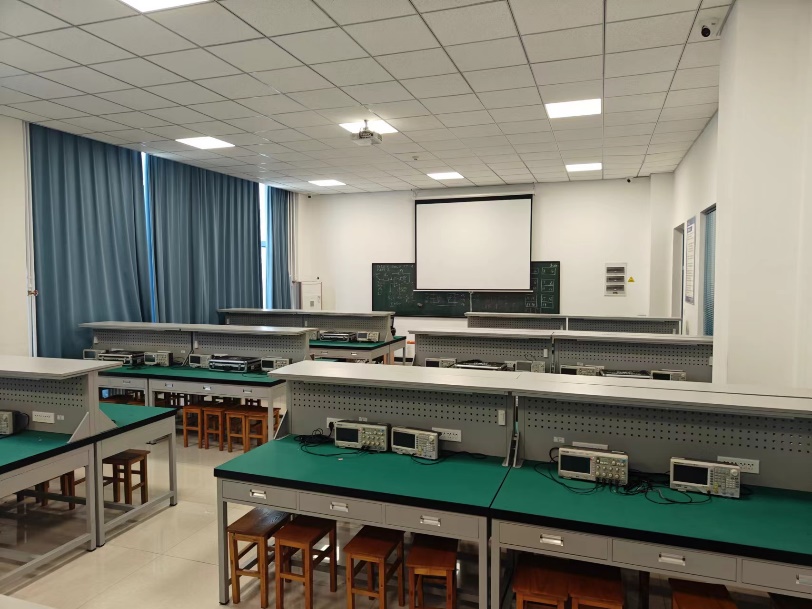
图2信息科学与工程学院光电子工程系电子电路实验室
Figure 2: Electronic Circuit Laboratory, Department of Optoelectronic Engineering,
School of Information Science and Engineering
实验课程共16学时,依托信息科学与工程学院光电子工程系电子电路实验室,开展实验课程的教学工作,如图2。由于软件工程专业共有3个教学班,合计75名学生,而实验室的空间和设备最多只能满足40名学生同时上课,所以将学生分为2组进行实验教学工作,学生自由结成2人一组的实验小组共同完成实验设计和测量工作,各自独立撰写实验报告。实验工作量设计适于由2名同学共同完成,2人结组完成实验可以更好地培养学生的沟通协作能力。
The Labs totaling 16 class hours, are conducted in the Electronic Circuit Laboratory of the Department of Optoelectronic Engineering, School of Information Science and Engineering of Yanshan University, as shown in Figure 2. Since the Software Engineering major has three teaching classes with a total of 75 students, and the laboratory space and equipment can accommodate a maximum of 40 students at the same time, students are divided into two groups for laboratory teaching. Students pair freely to complete experimental design and measurement work and are required to finish their own experimental reports. The experimental workload is designed to be completed by two students together and working in pairs can better cultivate students' communication and cooperation skills.
4.课程考核方式
4. Assessment Methods
《电子和测量》课程的考核方式由期末测试、实验报告和平时考核共同构成。其中,期末测试占60%的总成绩,通过西里西亚技术大学的Platforma平台出题,学生们考核的内容结构相同,但题目顺序随机打乱,同时所有学生的电路结构相同,但电路中电阻、电容、二极管等元件的特征参数随机,因此可以有效避免学生之间的作弊现象。实验报告占总成绩的40%,评分依据主要是学生电路设计的合理性、测量结果的正确性以及实验报告撰写的规范性。平时考核主要为签到,不计入总成绩,但如果学生缺课次数超过学校规定,将取消本门课程成绩。
The assessment method for Electronics and Measurements comprises a final examination, laboratory reports and regular attendance. Specifically, the final examination accounts for 60% of the overall grade, with questions generated via Silesian University of Technology's Platforma. Although all students are tested on the same content structure, question order is randomized, and while the circuit structures are identical for all, the characteristic parameters of components such as resistors, capacitors and diodes vary randomly. This effectively deters cheating among students. Laboratory reports contribute 40% to the total grade, with evaluation primarily based on the rationality of circuit design, accuracy of measurement results and standardization of lab report writing. Regular attendance is also monitored but does not directly contribute to the final grade; however, excessive unexcused absences will result in cancelling scores.
5.课程教学开展情况
5.Teaching Implementation
课程开课前,中方教师创建了课程的QQ群,用于课程相关信息的发布与学习交流。QQ群在课程教学中发挥了重要的作用,在教学过程中,中方教师实时将课程所涉及的专业英文词汇进行中文解释。外方教师通过Platforma教学平台,发布PPT课件供学生预习与复习,根据课程教学进度持续发布相应练习题,在实验课程前发布实验指导书和仪器操作注意事项与安全注意事项,学生自学内容等相关资料。图3为Platforma学习平台内容及自学电子资源。
Prior to starting the course, the Chinese instructor established a QQ(an instant messaging software) chat group which served as a platform for informing students and facilitating learning exchanges. The QQ group played a pivotal role in the teaching process, where the Chinese teachers can promptly offer help for students about professional vocabulary and jargons during the class. Meanwhile, the foreign teachers utilized the Platforma platform to upload PowerPoint presentations for student preview and review, giving corresponding exercise problems in line with the teaching progression and providing experiment manuals, instrument operation instructions, safety precautions and self-study materials before the lab class stared. Figure 3 illustrates the contents of the Platforma and the electronic resources available to self-study.
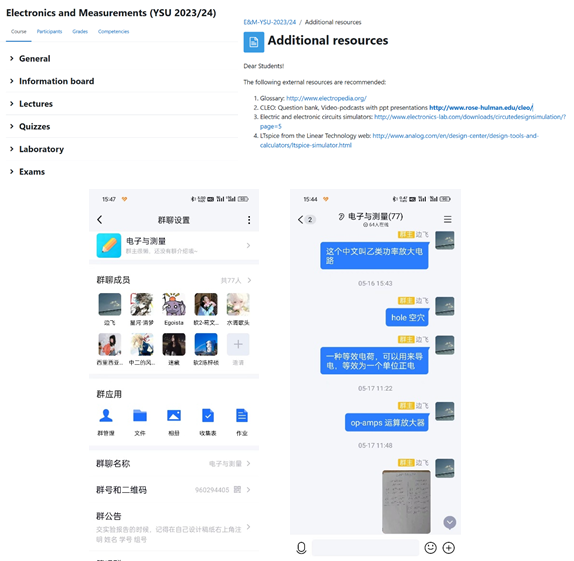
图3 Platforma学习平台内容及自学电子资源
Figure 3: Contents of the Platforma Learning Platform and Self-Study Electronic Resources
图4 课程交流QQ群
Figure 4: Course Communication QQ Group
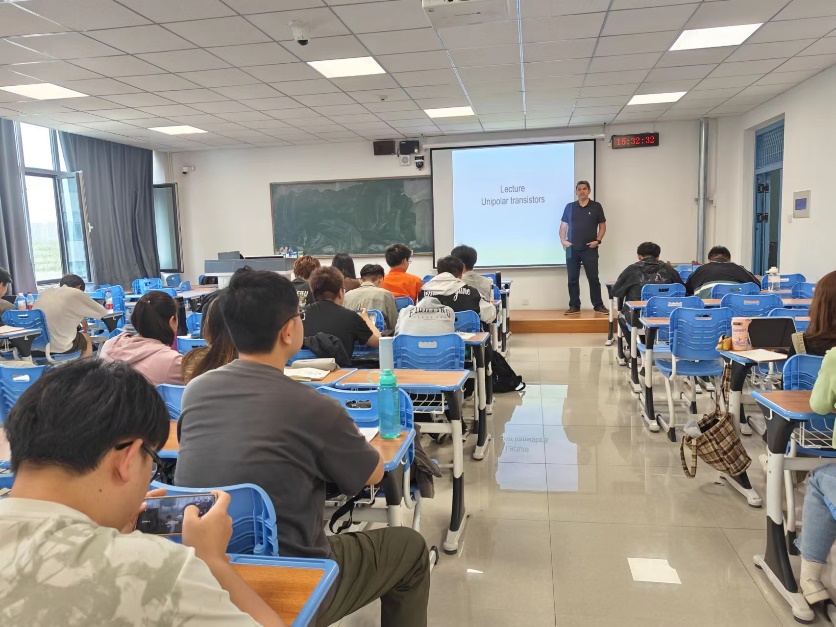
图5 Damian Grzechca教授课堂
Figure 5: Professor Damian Grzechca's Lecture Session
课堂教学由讲座课程和习题课共同组成,讲座课程由Damian Grzechca教授讲授,包括电路元件的基本原理、功能电路设计及应用等内容。讲授内容偏重应用方向,简单涉及元件特性的微观物理机理,着重介绍元件的宏观特性与电路应用及如何设计放大、滤波、选频等功能性电路,从应用的角度阐述电路设计中需要考虑的关键因素,培养学生的电子电路设计与分析能力。图5为Damian Grzechca教授讲课及边飞副教授助课照片。
Classroom teaching was comprised of lecture courses and problem-solving sessions. The lecture courses were instructed by Professor Damian Grzechca, covering topics such as the fundamental principles of circuit components, design of functional circuits and their applications. It focused more on the application, with a brief touch on the microscopic physical mechanisms of component characteristics and an emphasis on the macroscopic properties of components, their circuit applications and how to design functional circuits like amplifiers, filters, and frequency selectors. It focused on the key factors in circuit design from the perspective of application, cultivating students' abilities in electronic circuit design and analysis. Figure 5 displays a photograph of Professor Damian Grzechca lecturing with Associate Professor Bian Fei assisting.

图6 Lukasz Chruszczyk博士课堂
Figure 6: Class Conducted by Dr. Lukasz Chruszczyk
习题课由Lukasz Chruszczyk博士讲授,课程安排与讲座课程穿插进行,力求与讲座课程同步进行习题课练习。习题课首先进行基本电子电路原理与特性的分析,其目的在于使学生对所学电子元件的应用有初步的定量了解。然后进行功能性电子电路设计,着重介绍相关电路能够实现的功能,使得学生了解相关电路设计的原理与器件选择对设计结果的影响,培养学生的电路设计与定量分析能力。图6为Lukasz Chruszczyk博士课堂。
The Classes were conducted by Dr. Lukasz Chruszczyk, interspersing with the lecture courses to run concurrently wherever possible. The Classes started with analysis of the fundamentals of electronic circuit principles and characteristics to provide students with a primary quantitative understanding of the application of electronic components they have learned. The class then went to the design of functional electronic circuits, emphasizing the capabilities these circuits can deliver to help students comprehend the principles of circuit design and impact on the results by selecting different component, which fostered students' abilities in circuit design and quantitative analysis. Figure 6 shows Dr. Lukasz Chruszczyk offering problem classes.
实验课是《电子和测量》课程教学的另一重要内容,通过实际设计功能电路并通过示波器、万用表等设备对设计结果进行测量与分析,可以帮助学生更好地理解理论课堂所讲授的内容,同时也能够帮助学生认识到实际电子电路的设计和测量需要考虑的客观现实问题,能够极大地促进学生工程思维方式、动手能力、沟通协作能力的培养。
The lab class is also considered a vital part of Electronics and Measurements. By practically designing functional circuits, measuring and analyzing the results using oscilloscopes, multimeters, and other equipment, students gain a deeper understanding about the theoretical content covered in classroom lectures. Moreover, it acquaints them with the real-world challenges of electronic circuit design and measurement, significantly enhancing their engineering mindset, hands-on skills, and abilities of communication and collaboration.
实验课由中外双方4名教师共同指导,每次实验课的学生数在40人左右,这样可以保证师生比,确保教师可以对学生的实验进行指导并保证仪器使用和人身安全。实验课开始前,会在Platforma学习平台发布实验指导书,介绍每次实验课程需要设计的电路及原理,说明实验测量目标,给与学生对实验的初步概念。实验课开始时,外方教师会对实验电路与电路设计目标做进一步讲解,并讲述所用元件的引脚特征及实验所需仪器的使用方法。学生根据设计与测量目标,实际设计并组成电路,对电路的特征进行测量。
The laboratory class is jointly supervised by all four instructors from both Chinese and foreign sides, with each session accommodating around 40 students. The teacher-student ratio ensures personalized guidance, equipment and personal safety. Before class, a lab manual was given on the Platforma platform, outlining the circuits to be designed, explaining their principles, stating measurement objectives, and providing students with an initial framework for the experiment. During the lab, foreign teachers elaborated further on the experiment circuits, design objectives and the characteristics of component pins along with the operation of required instruments. Students proceeded to assemble and test their circuits according to their design and measurement goals and measure circuit characteristics.
为了有效避免组间学生的电路设计抄袭问题,教师对于每种元件都购买了多种规格并随机发给各组学生,由于元件特性参数的各异性,学生需要明确电路原理后,才能设计出相应的元器件参数选择,促进了学生电路设计能力的提升。
To effectively avoided plagiarism among groups, instructors procured components with different specifications and distribute randomly among teams. Students had to have a clear comprehension of circuit principles so that they could select appropriate component and finish circuit design. This promoted students’ circuit design proficiency.
由于实验所用器件的随机性,学生在实验报告中需要给出详细的电路设计过程,元件选用的考量因素和设计预期结果。同时要给出测量结果,并对测量结果进行分析,阐述是否达到了预期设计结果,并进行误差分析。如果测量结果与预期结果相差较大,还要分析其成因及可能的解决方案。
Due to the random components were used in experiments, students are required in their lab reports to explain detailed circuit design process including considerations of component selection and the anticipated outcomes and also present their measurement results and an analysis of the results. They needed to elaborate whether the intended design objectives were met and give an error analysis. If there is a significant discrepancy between the measured and expected results, students must further analyze the reason and potential solutions.
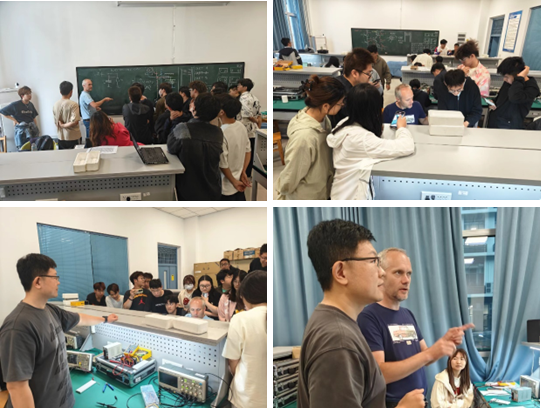
图7 中外双方教师共同指导学生实验
实验内容包括:
Figure 7: Chinese and Foreign Instructors Jointly Guiding Student Experiments
The experiment includes the following content:
实验1:LED二极管电路及Zener二极管电路设计与测量
Experiment 1: Design and Measurement of LED Diode Circuits and Zener Diode Circuits
学生根据所拿到的LED二极管和Zener二极管特性,设计相关电路并选用合适器件,实现LED正常发光及Zener二极管的安全工作。在设计的过程中需考虑让二极管工作在合理的电压电流范围,同时要注意电路连接的正确性并预估二极管功耗,防止损坏电源及二极管元件。
Students were required to design relevant circuits based on the characteristics of the LED and Zener diodes they have received, selected appropriate components and achieved normal illumination of the LED and safe operation of the Zener diode. In the design process, it was necessary to ensure that the diodes operate within a reasonable voltage and current range, meanwhile pay attention to the correctness of the circuit connections and estimating the power consumption of the diodes to avoid damage to the power supply and the diode components.
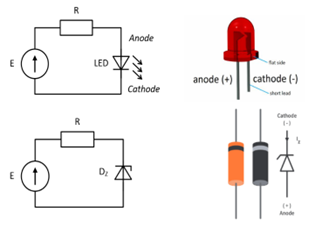
图8 LED和Zener二极管实验设计电路
Figure 8: Experimental Design Circuit for LED and Zener Diodes
实验2:整流电路设计及其特性测量
Experiment 2: Design and Characterization of Rectifier Circuits
分别设计并构建半波及全波整流电路,测量其输出波形特性。测量完成后,在输出端引入电容滤波,调整输入信号的频率,并测量电路的纹波特性。接入负载电阻,测量负载电阻的输出电压信号特性。
Students designed and constructed half-wave and full-wave rectifier circuits separately, and measured their output waveform characteristics. After the measurements were completed, a capacitor filter was introduced at the output terminal. Students adjusted the frequency of the input signal, and measured the circuit’s ripple characteristics. They connected a load resistor and measured the output voltage signal characteristics of the load resistor.
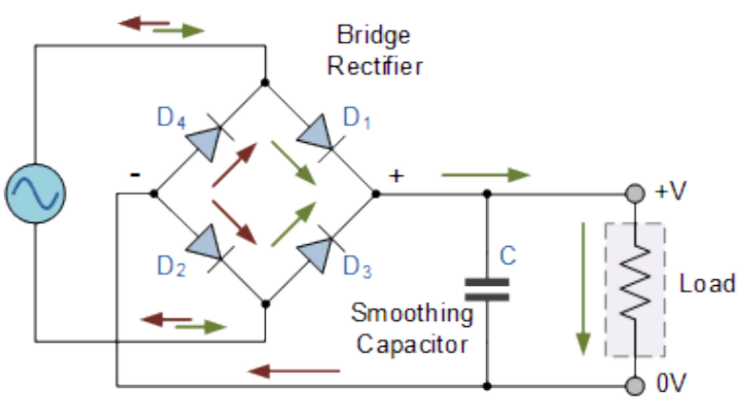
图9 整流电路设计与测量
Figure 9: Design and Measurement of Rectifier Circuit
实验3:三极管放大电路设计及其特性测量
Experiment 3: Design and Characterization of Transistor Amplifier Circuit
根据拿到的三极管设计一个放大电路,测量其晶态工作点和电压放大倍数,并通过调整输入信号的幅值探究电路的饱和电压。
Students designed an amplifier circuit based on the received transistor, measured its quiescent working point and voltage gain and explored the circuit’s saturation voltage by adjusting the amplitude of the input signal.
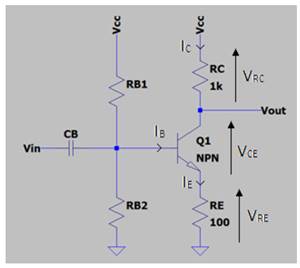
图10 三极管放大电路
Figure 10: Transistor Amplifier Circuit
实验4:三极管开关电路设计及特性测量
Experiment 4: Design and Characterization of Transistor Switching Circuit
设计并测量基于双极型晶体管(BJT)和单极型晶体管(FET)的开关电路。分析负载电容、基极电流和电阻对晶体管开关性能的影响。
Students designed and measured switching circuits based on bipolar junction transistors (BJT) and field-effect transistors (FET), and analyzed the effects of load capacitance, base current and resistance on the switching performance of the transistors.
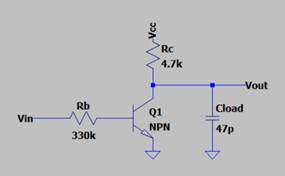
图11 三极管开关电路
Figure 11: Transistor Switching Circuit
实验5:集成运算放大器电路设计
Experiment 5: Design of Integrated Operational Amplifier Circuits
设计和构建不同类型的运算放大器电路,包括反相放大器和同相放大器。测量运算放大器在不同输入条件下的响应,分析并测量运算放大电路的饱和现象。
Students designed and constructed different types of operational amplifier circuits, including inverting amplifiers and non-inverting amplifiers, measured the response of the operational amplifiers under different input conditions, analyzed and measured the saturation phenomena of the operational amplifier circuits.
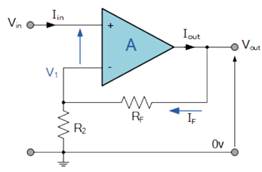
图12 集成运放电路
Figure 12: Integrated Operational Amplifier Circuit
图13给出了一名学生实验报告的示例,报告中写明了学生所设计元件参数及近似选用的元件,给出电路连接实物图并得出实际测量结果。
Figure 13 shows an example of a student’s lab report, which details the designed component parameters and the approximate components used, providing a physical diagram of the circuit connections, and presents the actual measurement results.

图13 学生实验报告示例
Figure 13: Example of Student Lab Report
在课程教学过程中,教师会在课堂中提问并对回答优秀的学生发放小礼品奖励,促进学生听课的积极性和思考主动性。课程所有内容结束后,外方教师对Platforma系统中习题回答优秀的学生进行奖励。在整个教学过程中,学生们积极与中外教师互动,不但提升了学生的专业知识更提升了学生们的国际视野和英语交流能力。
During teaching process, teachers asked questions in class and students with excellent answers would be rewarded with small gifts to encourage engagement and initiative in thinking. At the end of the course, foreign teachers also rewarded students who have excelled in exercises on the Platforma system. Throughout the teaching process, students actively interacted with both Chinese and foreign teachers. They not only enhanced their professional knowledge but also broadened their international perspective and improve English communication skills.
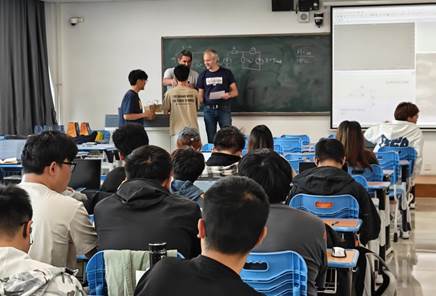
图14 外方教师为优秀学生颁奖
Figure 14: Foreign Teacher Awarding Prizes to Outstanding Students

图15 中外师生合影
Figure 15: Group Photo of Chinese and Foreign Teachers and Students
三、展望
Future Work
在《电子和测量》这门课程的教学过程中,力求在课程前期即拓宽学生的国际视野,通过引入全球电子工程领域的最新进展与案例,丰富学生的国际视野,为日后的跨国界学术合作与交流构建坚实的文化及语言基础。课程设计中,我们将大幅增加互动式学习模块,比如讨论课和实验环节,鼓励学生主动参与课堂活动,不仅作为听众,更作为积极的参与者和创造者,以此激发他们的批判性思维和创新潜能。
In the teaching process of Electronics and Measurements, we have strived to broaden students’ international perspectives from the early stages of the course. By introducing the latest advancements and case studies in the global field of electronic engineering, we have enriched students’ international understanding and laid a solid cultural and linguistic foundation for future cross-border academic collaboration and exchange. In future course design, we will significantly increase interactive learning modules, such as seminars and laboratory sessions, encourage students to actively participate in classroom activities, not just as listeners, but as active participants and creators, in order to motivate their critical thinking and innovative potential.
依托并优化现有的国内实验资源,我们将推动实验课程体系与国际先进标准接轨,促进实验内容与国际最新科研成果的融合,建立一个既符合国内实情又对接国际水平的实验室环境。实现国内外教育资源的有效整合,让学生在实践中体验跨文化的团队合作,培养全球化背景下的科研合作能力。通过这些创新举措,不仅传授电子与测量的核心知识,更引导学生在全球化背景下成长为具备国际竞争力的电子工程师和科研创新人才。
Relying on and optimizing our existing experimental resources, we will improve the experimental curriculum system in line with international advanced standards, facilitate the integration of experimental content with the latest international research achievements, and build a laboratory environment in accordance with both domestic realities and international levels. By effectively integrating domestic and international educational resources, we will encourage students to experience cross-cultural team cooperation, cultivate their capacity for global scientific research cooperation. Through such innovative measures, we expect to not only impart the core knowledge of electronics and measurements to students but to guide them to grow into electronics engineers and research and innovation talents with international competitiveness in the context of globalization.

